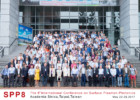Quantum superposition at the half-metre scale
The quantum superposition principle allows massive particles to be delocalized over distant positions. Though quantum mechanics has proved adept at describing the microscopic world, quantum superposition runs counter to intuitive conceptions of reality and locality when extended to the macroscopic scale, as exemplified by the thought experiment of Schrödinger’s cat. Matter-wave interferometers, which split and recombine wave packets in order to observe interference, provide a way to probe the superposition principle on macroscopic scales and explore the transition to classical physics. In such experiments, large wave-packet separation is impeded by the need for long interaction times and large momentum beam splitters, which cause susceptibility to dephasing and decoherence. Here we use light-pulse atom interferometry to realize quantum interference with wave packets separated by up to 54 centimetres on a timescale of 1 second. These results push quantum superposition into a new macroscopic regime, demonstrating that quantum superposition remains possible at the distances and timescales of everyday life. The sub-nanokelvin temperatures of the atoms and a compensation of transverse optical forces enable a large separation while maintaining an interference contrast of 28 per cent. In addition to testing the superposition principle in a new regime, large quantum superposition states are vital to exploring gravity with atom interferometers in greater detail. We anticipate that these states could be used to increase sensitivity in tests of the equivalence principle, measure the gravitational Aharonov–Bohm effect, and eventually detect gravitational waves and phase shifts associated with general relativity.
Nature 528 530 doi: 10.1038/nature16155
Nature Physical Sciences Research
Copyright protection for works of art – free consulting, IP Protection of your software
Protection of copyright for any creative works and inventions, patents US. Consulting on all matters of intellectual property rights in the US




